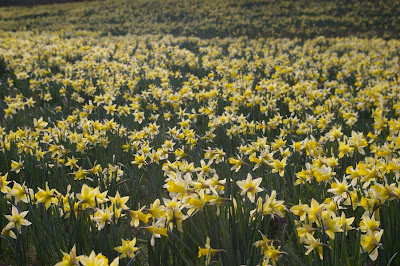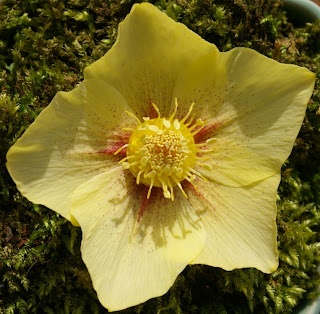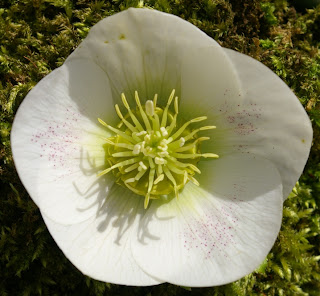 |
| A rather blue Sweet Violet in a Cotswold hedgerow. |
I've always thought the jingle 'Roses are red, violets are blue...' was rather silly, because violets aren't blue - they're violet! But colour perceptions vary and their nomenclature and usage varies - and flowers vary too. There is a good technical description of what constitutes violet in terms of wavelength of light, etc, on
Wikipedia, but the important conclusion is that it is a shade of purple leaning more to blue than to red. It is indeed the predominant colour, in different shades, of the flowers of
Viola section
Viola, the group known as violets.
 |
| Viola odorata |
The past few days of glorious warm sunny weather have seen violets at their peak round here, with all four local species in flower. The unscented
V. reichenbachiana,
V. riviniana and
V. hirta are rather unvaried, but the scented Sweet Violet,
V. odorata, appears in a wide range of colours and shades. I've always taken the dark purple form (left) to be normal, and indeed the archetype of the colour violet. It is a plant of shortish, woodland edge or hedgerow vegetation, but also thrives in short grass that isn't mown too intensively.
As a wild plant round here the flower colour varies considerably, with paler and darker shades of violet, becoming almost blue, as above, or to reddish purple, and white forms are common. These may or may not have purple or pink patches on the outside of the petals or spur, though some pigmentation is normal. In the gardens at Colesbourne Park, thriving in the grass, are masses of violets in the volet and white ranges plus a lot in tones of (it has to be said) a rather dull and dirty pink, but together and en masse they look delightful. It is possible that these are descendants from old garden cultivars rather than truly native here.
 |
| A posy of violets from Colesbourne Park, showing the range of colour variants. |
 |
| Three colours together in the turf at Colesbourne Park. |
Viola odorata spreads quite vigorously by stolons, and produces masses of apomictic seed, so it is possible for quite large patches of a single form to develop: white forms are most conspicuous and their large colonies can often easily be spotted from the car, as I did with the patch shown below.
 |
| White violets in a roadside ditch. |
Gardeners have selected a large numbers of Sweet Violet cultivars for flower size, fragrance and colour. There are many good red and clear pink ones and a soft yellow, 'Sulphurea'. Visiting Cotswold Garden Flowers last weekend I pounced on a pot of 'Phyl Dove', which has astonishingly peach-coloured flowers, a shade I'd not seen before. It is said not to be scented, but it is fragrant in the evening. Another acquisition was an abundantly flowering pot of 'Bruneau', one of the double-flowered Parma violets (which are probably hybrids), which has an incredibly strong scent: brought inside it perfumed the whole house, and had to be removed at dinner time as its scent interfered with the flavour of the meal.
 |
| 'Phyl Dove' |
 |
| The wonderfully fragrant 'Bruneau' - outscents all the others. |







































































